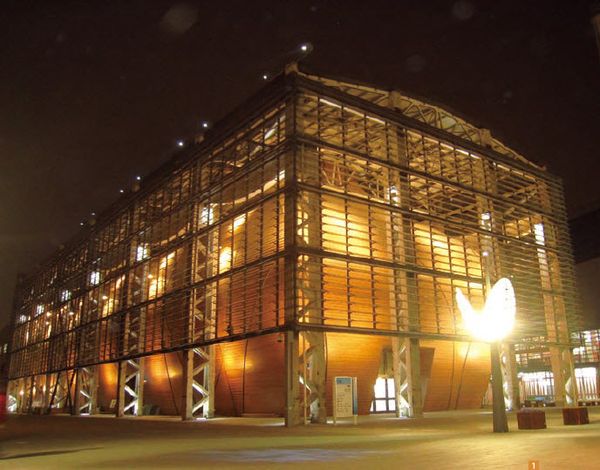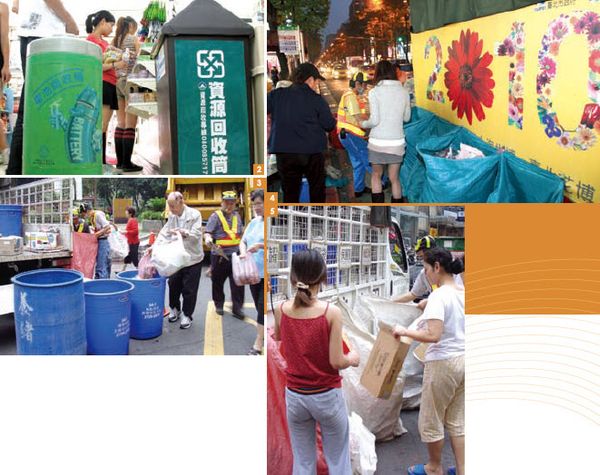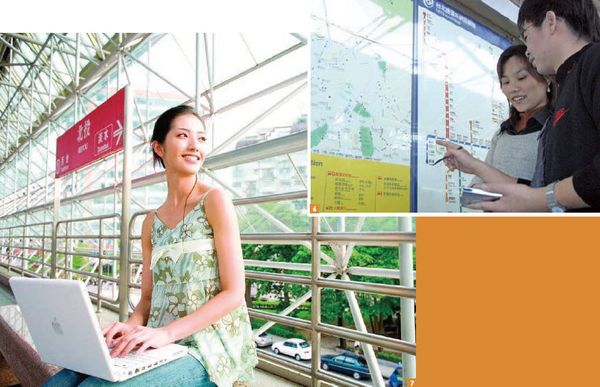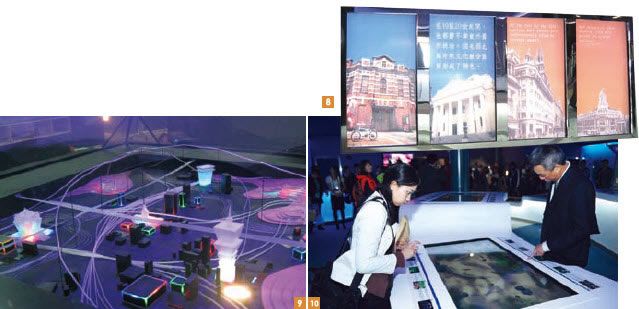Taipei Smiles: Expo 2010 Shanghai
The Taipei Pavilion has“wireless broadband”and “resource sustainability”as its two core proposals. Taipei's success is shared to the world for the city has the most extensive public wireless-broadband network on the globe, plus its promotion of waste reduction and recycling is havaing splendid results. The Taipei exhibition facilities have been designed and constructed following the 3R approach—Reduce, Recycle, Reuse—and the World Expo's international selection committee was impressed enough that Taipei was the first city to have two proposals granted. Eco Taipei:Promoting Urban Sustainability Taipei's residents have been working towards the total recycling of resources, the small efforts of individuals aggregating into an exceptional achievement for the city as a whole. In fact, Taipei's household-garbage volume fell from 2,970 metric tons per day in 2000 to just 1,009 metric tons per day in 2009, a 67% decline. Over the same period, the volume of recycled materials grew from just 2.4% of total waste to 45%. To maximize the recycled materials and achieve the“zero landfill”objective, Taipei has included everything with the potential for reuse in its “recyclable”category. For example, kitchen leftovers are fed to pigs or composted; bicycles, old furniture and other large items are repaired or refurbished by skilled teams at the city government's Department of Environmental Protection, then sold cheaply to residents who need them; sewer sludge is filtered and used as fill or in agriculture; and ash from the city's garbage incinerators is used by private companies as an additive when making concrete, surfacing roads, and backfilling pipe trenches. Taipei's success in reducing its volume of solid waste has eliminated the need for a planned third incinerator, contributing enormously to the city's environmental protection efforts. Intelligent Taipei : Making Lives Better The Taipei City Government began promoting Cyber City project in 1999, and completed implementation of the first two stages of the project within eight years. The goal of stage one (1999-2002) was to encourage residents to utilize online services“Frequent the Internet, Free Up the Road.”The stage involved building a network for city-government business and delivering citygovernment non-stop services online around the clock. Stage two (2003-2006), called“Digital City, Mobile Taipei,”involved building wireless networks in public areas of the city and schools, enhancing e-Government services, and improving residents' digital lives. In an effort to save energy and reduce carbon emissions, the Taipei City Government is actively encouraging res ident s to make use of publ ic transportation. Intelligent signs at bus stops, telephone hotlines, and cell phones enable residents to check on the current status of public vehicles, making it more pleasant and convenient to ride public transportation. Meanwhile, the Intelligent Transportation System (ITS) provides automobile drivers with cell-phone-accessible information on the availability of parking spaces. To date, Taipei has issued more than 1.82 million EasyCards. These non-contact, rechargable prepaid cards integrate multiple functions that currently include payment of transit and parking fees. On April 1, they acquired the ability to make small purchases, meaning that cardholders will be able to use their EasyCards to pay for purchase at convenience stores, making it easier still for city residents to use one card for everything. Three Major Theme Areas Highlighting the Charms of Taipei City to You At the 101 3D Theater the film Taipei.Life.Smile is shown. Created by internationally acclaimed Taiwanese director Hou Hsiao-hsien, eleven professional cameras and a high-definition 3D camera were used to finish the shoot, combining the two techniques with visual effects to craft an enticing three-dimensional work, which immerses the viewer into experiencing the vigorous daily life of Taipei. At the Interactive Gallery visitors can experience Taipei's natural ecology and its world of arts and humanities. There are five major themes: Eco Taipei, Discover Taipei, Lovely Taipei, A Story of Two Cities, and Taipei Smiles. With Eco Taipei, visitors use touch panels to travel upstream against the currents of time in order to understand the pollution remediation of the Danshui River. With Discover Taipei director Hou Hsiao-hsien introduces the many faces of Taipei via an excursion through her cultural and natural environments. With Lovely Taipei you are taken on a whirlwind tour of the city's most famous and beloved tourist sights, and there are even nifty services for photo taking and the sending of photo e-files. In the A Story of Two Cities area you see the stories of Taipei and Shanghai with their criss-crossing paths through the unfolding of time, told with word and picture, experiencing times of war and glory, times of vicissitudes and reform. Finally, in the Taipei Smiles area, the vitality and creativity of the city's denizens are placed front and center, with photos and messages displayed for the entire world to see the smile of these industrious people and the strength of the city. See you at the Taipei Pavilion during the World Expo, where we are proud to show you just what this city of vision and charisma is made of! Exhibition Period: May 1 ~ Oct. 31
Launched on May 1, Expo 2010 Shanghai is the first ever to have an explicitly urban theme. And Taipei as a leading international metropolis wouldn't miss it for the world!
Taipei implemented a system of“Per-Bag Trash Col lect ion Fee”in July 2000. Since then, city residents have been required to dispose of their non-recyclable waste in designated bags. The city government's incentive system—less waste means lower fees—has given residents greater motivation to separate their garbage.
For the last ten years, Taipei has been endeavoring to remake itself into a new“CyberCity”by aggressively ins tal l ing wi reles s broadband communicat ions infrastructure and promoting e-Government initiatives. The Intelligent Community Forum (ICF) recognized these efforts in 2006 when it named Taipei its“Intelligent Community of the Year.”
The Taipei Pavilion is located in the Urban Best Practices Area (UBPA) of the Expo's Puxi Site. It features three large exhibit areas—“101 3D Theater”, “Theater of the Future”, and“Interactive Gallery”—where the wireless broadband and resource sustainability concepts are given form. 
Information Taipei Pavilion / Expo 2010 Shanghai
Location:
Expo in downtown Shanghai, both sides of Huangpu River, riverside area between Nanpu Bridge and Lupu Bridge; pavilion at Puxi Site, UBPA, B4-3

![Taiwan.gov.tw [ open a new window]](/images/egov.png)
